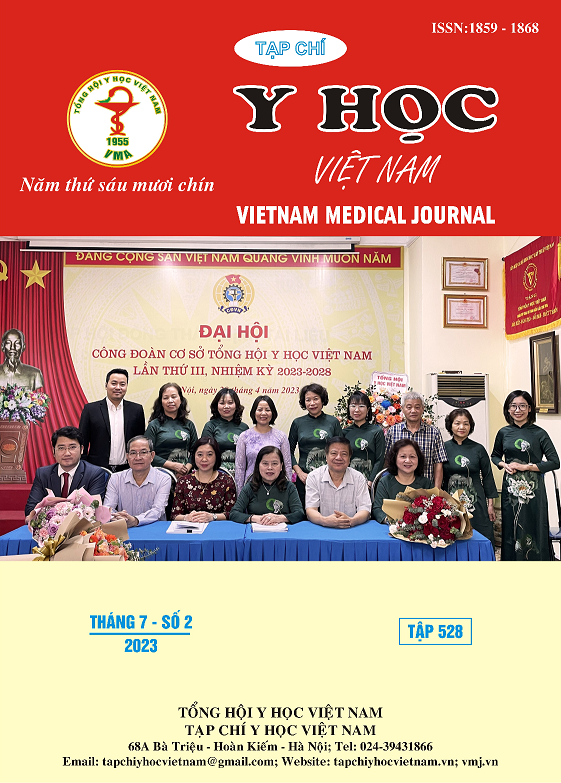EVALUATION OF THE RESULTS OF RADICAL GASTRECTOMY FOR GASTRIC CANCER TREATMENT AT MILITARY HOSPITAL 103
Main Article Content
Abstract
Objectives: To review some clinical and sub-clinical characteristics and evaluate the results of radical gastrectomy for gastric cancer treatment. Patients and research methods: a retrospective, cross-sectional study of 108 patients undergoing radical gastrectomy for gastric cancer from February 2018 to June 2021 at Military Hospital 103. Results: There were 108 patients undergoing radical gastrectomy: The mean age was 61.8 ± 12.1 years (23 - 85), male accounted for 75.9%, female accounted for 24.1%. ASA= 2 (63.9%), ASA = 3 (36.1%). Stage IB, IIA, IIB, IIIA, IIIB, IIIC were 20.4%, respectively; 18.5%; 21.3%; 11.1%; 16.7%; 12.0%. Cell type: tubular adenocarcinoma: 84.3%; signet ring cell carcinoma: 9.2%, mucinous adenocarcinoma: 6.5%. Technique: sub-total gastrectomy 92,6%, total gastrectomy 7.4%; Roux-en-Y: 79.6%, Polya 8.3%, Pean 12.1%. The average number of dissected lymph nodes was 27.2 ± 8.2 nodes (14 -63). Postoperative complications: wound infection: 4.6%; duodenal fistula 1.9%, small bowel obstruction 1.9%; intra-abdominal bleeding 0.9%. Average hospital stay after surgery 7.2 ± 2.3 days (7-18). The mean additional survival time after surgery was 44.8 ± 3.5 months. Projected disease-free survival rates after 1 year, 2 years, 3 years, 4 years, respectively: 96.0%; 80.2%; 73.3%; 57.4%. Assess quality of life after surgery with Spitzer scale: 5 - 6 points; 7 - 8 points; 9 - 10 points respectively: 18.5%; 39.8%; 41.7%. Conclusion: Radical gastrectomy is an effective and preferred method of gastric cancer treatment, with positive surgical results with low complication rate, early postoperative recovery time, and better recovery time. Longer postoperative survival time for patients.
Article Details
Keywords
radical gastrectomy, gastric cancer, radical gastrectomy
References
2. Chen, K., et al., Short-term surgical and long-term survival outcomes after laparoscopic distal gastrectomy with D2 lymphadenectomy for gastric cancer. BMC Gastroenterol, 2014. 14: p. 41.
3. Chen, Z., et al., Complication Rates in Different Gastrectomy Techniques of Enhanced Recovery after Surgery for Gastric Cancer: A Meta-analysis. J Coll Physicians Surg Pak, 2022. 32(10): p. 1318-1325.
4. Wu, C.W., et al., Quality of life of patients with gastric adenocarcinoma after curative gastrectomy. World J Surg, 1997. 21(7): p. 777-82.
5. Cianchi, F., et al., Robotic vs laparoscopic distal gastrectomy with D2 lymphadenectomy for gastric cancer: a retrospective comparative mono-institutional study. BMC Surg, 2016. 16(1): p. 65.
6. Shimada, H., et al., Clinical significance of serum tumor markers for gastric cancer: a systematic review of literature by the Task Force of the Japanese Gastric Cancer Association. Gastric Cancer, 2014. 17(1): p. 26-33.
7. Catarci, M., et al., Lymph node retrieval and examination during the implementation of extended lymph node dissection for gastric cancer in a non-specialized western institution. Updates Surg, 2010. 62(2): p. 89-99.
8. Küster R, G.B., Stützer H, Salzberger B, Ahrens P and and R.H. (1987), Quality of Life in Gatric Cancer: Karnofsky’s Scale and Spitzer’s Index in Comparision at the Time of Survey in a Cohort of 1081 patients. Scandinavian Journal ò Gastroenterolog. 22, 133: p. 102 - 106.


